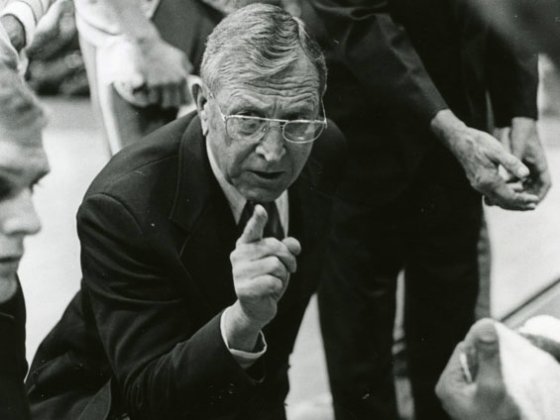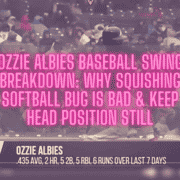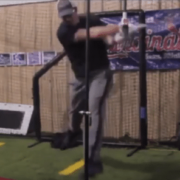How You Can Teach Effective Hitting Mechanics Almost Instantly
“I am just curious to see what are the steps the coaches are using to teach this system? There is a ton of great information but what have you done to break it down. I cant throw all this info and steps at a player and expect them to retain the info. So, what have you focused on from start to finish? IE. Grip, Break it apart drill, Tuck front shoulder, Fight Position, Finish? Thank you”
– Coach Sullivan

The legendary UCLA basketball Coach John Wooden. Photo courtesy: FunctionalTrainingPathBlog.com
I received this on my Coaches Forum recently, which is included as part of any online video course of mine one would invest in.
It’s a great question, and one I don’t feel the coaching community has done a good job of answering (me included…until now).
Sure, an online hitting guru may get favorable results with their hitters, but how do they actually teach and progress the swing mechanics to get those results?
I’m attempting to shed some light on that in this post.
Look, let me be up front…
There’s no perfect place to start with a player’s swing. Every coach will have a differing opinion on this based on a myriad of factors, so please use the following as a guideline or suggestion, and deviate when necessary.
What I do know is this,
You can’t go wrong with scratching the immediate hitter’s itch.
In this post, we’ll attack Coach Sullivan’s question from above in the following ways:
- Mechanical steps to focus on first – scratch the itch,
- Breaking down drill progressions,
- Mindset when working on something new,
- Transitioning practice into game swings, and
- Player’s homework for home.
Let’s get started…
Mechanical Steps to Focus on First – Scratch the Itch
I ask the parent of my hitters (or the hitters themselves), what part of their swing needs the most help. Here are the questions I typically ask:
- Looking back on the season (or past season), where did you hit the ball more…on the ground, line drive, or fly balls? Can you attach a percentage to each?
- Looking back on the season (or past season), where did you hit the ball more…to left field, center, or right? Can you give me a percentage of each?
- Do you feel like there’s more lack of power or solid contact?
To test their answers to these questions,
I can also put the hitter on a tee, setup where they should hit the ball to center-field, and have them take 10 swings, while capturing their Ball Exit Speed with a radar gun. Generally speaking, this will tell me where they’re hitting the ball direction-wise, and with what kind of impact quality. And it’s not how high the radar gun goes, but how consistent and stable their numbers are.
Armed with this data, I can now formulate a semi-solid swing plan. The next step is confirming my assumptions through video analysis, in which I use the HudlTech or CoachesEye app on my phone. I use Powerchalk.com for my online hitters.
The first session is the same with all my hitters (from 7-years-old to 24-years-old), we address how to consistently get into the box, the gorilla grip, and Finger Pressure.
After these are covered, and I can now hold the hitter accountable for them, then I dive into a swing solution that scratches the immediate itch…
Before jumping into mechanics I make sure my hitters are moving better, so they can perform better by following this simple plan for better mobility and stability.
If a player is struggling with contact, then I start with Footwork, Knee Action, and Barrel Path as described in The Pitch-Plane Domination and Reaction Time Mastery online video courses.
Or,
If a player is struggling with consistent power (radar readings are below average and unstable from swing to swing), then I start with ‘Showing Numbers’, ‘Side Bending’, ‘Hiding Hands’, and Hunched Position as described in my book and The Catapult Loading System online video course.
Breaking Down Drill Progressions
How do we teach a brand new motor skill to a budding young athlete?
Please keep in mind, the speed of drill progression will depend on the player’s age, “trainability” as talked about in David Epstein’s book The Sports Gene, and the player’s early movement development.
This is how to teach the teaching of the mechanics, if you will.
So think about drill progressions as what you do in the weight room.
What happens if you do a back squat with the same weight, 2-3 days per week, 3-sets and 12-repetitions every workout, 52-weeks per year? Right! You’ll plateau early on and make zero gains the rest of the year. You’ll be wasting your time and money in the weight room.
In the case of squatting, how do you get a body and/or strength change in the squatter above?
By adjusting the intensity (total weight lifted), accomplished sets, amount of repetitions, type of squat (front v. back), and rest time. Change MUST be a constant if you want the body to adapt accordingly. These are drill variables that can drive skill adaptation in hitters as well.
When teaching a brand new hitting technique, I move through the following swing progressions (from easy to more difficult):
- Dry swings,
- Tee swings,
- Soft Toss, then
- LIVE or front toss.
If the hitter can produce the new swing technique eight out of ten dry swings, then I move them to tee swings, and so on and so forth. Think of these progressions as weight-lifting for the mind.
I will also slow things down movement-wise for the hitter by breaking the swing apart into three steps at first with the Break-it-Apart Drill (not really a Drill per se, but more of a way to drill the Drills):
- Getting to the landing position (Fight),
- Pause for a second or two, and then
- Swinging.
This allows the player to slow the swing process down to focus on the fix. So putting these drill progressions together would look something like this:
- Break apart dry swings (after 8/10 successful reps, move onto the next),
- Put swing together dry swings (after 8/10 successful reps, move onto the next),
- Break apart tee swings (after 8/10 successful reps, move onto the next),
- Put swing together tee swings (after 8/10 successful reps, move onto the next),
- Break apart soft toss swings (after 8/10 successful reps, move onto the next),
- Put swing together soft toss swings (after 8/10 successful reps, move onto the next), and lastly
- Put swing together LIVE or front toss swings (after 8/10 successful reps, move onto the next).
Mindset Working on Something New
What if I timed you 10-times writing your name using all letters and took the average, then timed you 10-times writing your name in half the letters? So for me, Joey Myers, I would write J-E-M-E-S.
Well, the first few times writing your name in half the letters would be slower, but as your brain learned to do it after the first 2-3 times, you’d actually write your name in half the letters 1/3 the time it takes to write your full name!
Who cares? Your players do.
I tell my hitters that you’ll take a step back before you take two forward when learning to do something new.
Mindset is EVERYTHING when your players are learning a brand new movement.
Your players MUST know that you’re grading them on the process, NOT the outcomes…at first.
In other words, I tell my hitters that if they swing and miss, but do what I want them to do mechanically…they get an ‘A’ for that swing. If they hit a fiery hole through the back netting of the cage, while not doing what I wanted them to do mechanically…then they get an ‘F’ for that swing.
You following me here?
They need to go into observe mode on outcomes, not analytical mode, in the beginning. This is crucial especially with my online lessons because I’m not there to physically work with the hitter. So when a mom or dad says our hitter is doing what I want them to do off the tee, but not during LIVE batting practice. Most likely this is a mindset issue. The hitter is more focused on OUTCOMES hitting LIVE, not solely on the process like they should be.
A lot of times, I throw out plate discipline and timing completely in the beginning (in other words, I’m not grading them on those).
Transitioning Effective Practice Swings into Games
I did a comprehensive post on this already, so CLICK HERE for that. Please read that first, then continue on in this post.
Player’s Homework for Home
Look parents, you can’t expect your kids to go to practice three or four times a week and expect them to get better. Can I get an Amen from the coaches here?!
Most times, the kids don’t even hit at practice. And if they do, it may be once per week with the team. And if they do hit every practice, who says the player is even focusing on their specific “new hitting process”?
You see, for the most part, head coaches are generalists. It’s not until High School that programs get a specified hitting coach. And many programs at that level, don’t even have that!
Here’s my point…
Don’t count on organized practices to get “new hitting process” work in.
There comes a time when a hitter MUST be accountable for their own success. And to set the player up for success at home, here’s what I ask of my hitters:
- Give me at least 4 or 5 days per week (team practice days don’t count), and
- At least 5-minutes each day.
That’s it! Most kids play at least 30-60 mins of videos games per day…wanting 5-minutes per day for hitting homework isn’t asking that much. Just set an alarm, and when it goes off, then the player is done for the day. Simple.
The hitter can put in more time, but I don’t recommend early on, especially if they’re at a lower motivational level. Once they start experiencing success at the plate in games, they’ll be inspired to put in more time, trust me.
I prescribe at least four or five days per week for their hitting homework because it’s based on what I’ve seen with my players. I ask them at the start of a lesson, how many days per week they got their hitting homework in at home? And typically, the ones sharing three days or less, we’re having to revisit what we worked on last lesson. For most reporting four or more days, we’re moving forward with their swing.
One last thing that fires up inspiration (good or bad) for my players is to compare their current swing to the the last one using video analysis. I tell them it’s our version of a quiz on how they did for the week.
Remember in this post, we went over:
- Mechanical steps to focus on first – scratch the itch,
- Breaking down drill progressions,
- Mindset when working on something new,
- Transitioning practice into game swings, and
- Player’s homework for home.
Coaches, please share anything else I may have missed that has worked extremely well for your hitters. THANKS in advance…
- Fix Late Swings Fast: 2025 Pitch Recognition & See-Decide-Swing Training for Youth Baseball Power Hitters - October 6, 2025
- Safe Youth Weighted Bat Training: Proven Overload/Underload Drills to Increase Exit Velocity in Games Starting Tonight - September 29, 2025
- AI Coaching Course 2025: Youth Baseball & Softball Practice Plan + Off-Season & In-Season Workout Builder Fast - September 23, 2025












Thought this was interesting https://youtu.be/p6PSj1PjNuI
I saw that! “You throw like a girl” doesn’t have same negative connotation like it did back in the old days 😉